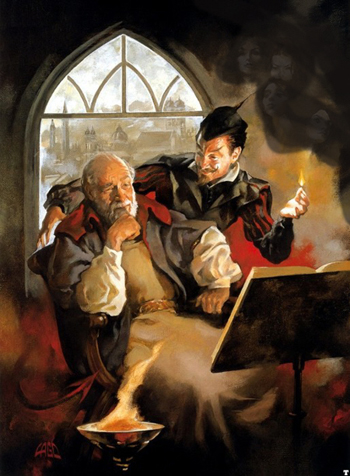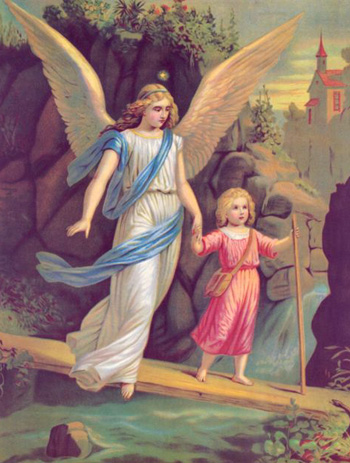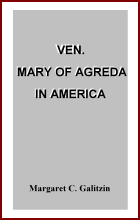Ambiences and Tendencies
 |
 |
 |
 |
 |
 |
 |
Is the Guardian Angel Less Intelligent
than the Demon?
The Church teaches that God created the Angels far superior to us. With lucid intelligence and great power, these pure spirits by their nature exceed even the most gifted men. With their revolt the bad angels lost their virtue, but not their intelligence or power. Habitually God restrains their actions – at times more, at times less – according to the designs of His Providence. But, of themselves and according to their nature, these bad angels still continue to be far superior to man.
 Hence, the Church has always approved of artists depicting the Devil as an intelligent, astute, cunning and powerful being, yet full of malice in all his scheming. She even approved that this art present the Devil as a being with fascinating charms, to signify that the spirit of darkness can take on attractive guises in order to seduce men.
Hence, the Church has always approved of artists depicting the Devil as an intelligent, astute, cunning and powerful being, yet full of malice in all his scheming. She even approved that this art present the Devil as a being with fascinating charms, to signify that the spirit of darkness can take on attractive guises in order to seduce men.
* * *
In our first picture, we have an example of this presentation of the demon. Mephistopheles, with a sharp, astute countenance of a cunning and penetrating psychologist, suggests soft and profound thoughts of perdition to the dreamer Doctor Faust, who is resting in his chair.
This type of representation has become so frequent that the demon is hardly ever imagined otherwise.
All this is, as we have said, perfectly orthodox.
* * *
What can we make of a certain iconography of good Angels?
They are shown to us as eminently well-intentioned, happy and candid beings. All this is in conformity with the holiness, bliss and purity that they possess in the highest degree.
But, these representations are excessive. In trying to accentuate, on one hand, the goodness and purity of the faithful Angels and, on the other hand, without knowing how to express their intelligence, their strength and their admirable majesty, these representations depict, instead, insipid beings of no value.
 Our second picture shows a child crossing a stream on a bridge. A Guardian Angel protects her. The picture, common and unpretentious, does not fail to arouse legitimate sympathies, as it pleasantly evokes a country panorama with the village steeple in the background, a scene impregnated with the innocence of life that can more easily be preserved in the countryside than in cities. At the same time, it elicits the touching idea of a child who follows her carefree path protected by a heavenly Prince, who shelters her lovingly.
Our second picture shows a child crossing a stream on a bridge. A Guardian Angel protects her. The picture, common and unpretentious, does not fail to arouse legitimate sympathies, as it pleasantly evokes a country panorama with the village steeple in the background, a scene impregnated with the innocence of life that can more easily be preserved in the countryside than in cities. At the same time, it elicits the touching idea of a child who follows her carefree path protected by a heavenly Prince, who shelters her lovingly.
But, let us consider the face of this Prince: Does he not seem completely lacking in that force, that intelligence, that intensity and that subtlety proper to the angelic nature and with which Satan is always represented? Let us pay attention to the body attributed to the good Angel: a soft, flowing and unintelligent attitude. Let us compare it with the slender agile figure and highly expressive physiognomy of Mephistopheles: Can there be a greater difference?
In all of this a serious drawback arises. Insistently representing the Devil as intelligent, lively and capable, and always representing the good Angels as soft, inexpressive and almost foolish beings – as does a certain sugary iconography – what impression does this create in the people’s souls? An impression that virtue produces shallow and stupid-looking beings and, on the contrary, vice forms intelligent and manly spirits.
In this we find another aspect of that sentimental sweetness that romanticism has so profoundly wielded, and still continues to wield, in many religious milieus.


In our first picture, we have an example of this presentation of the demon. Mephistopheles, with a sharp, astute countenance of a cunning and penetrating psychologist, suggests soft and profound thoughts of perdition to the dreamer Doctor Faust, who is resting in his chair.
This type of representation has become so frequent that the demon is hardly ever imagined otherwise.
All this is, as we have said, perfectly orthodox.
What can we make of a certain iconography of good Angels?
They are shown to us as eminently well-intentioned, happy and candid beings. All this is in conformity with the holiness, bliss and purity that they possess in the highest degree.
But, these representations are excessive. In trying to accentuate, on one hand, the goodness and purity of the faithful Angels and, on the other hand, without knowing how to express their intelligence, their strength and their admirable majesty, these representations depict, instead, insipid beings of no value.

But, let us consider the face of this Prince: Does he not seem completely lacking in that force, that intelligence, that intensity and that subtlety proper to the angelic nature and with which Satan is always represented? Let us pay attention to the body attributed to the good Angel: a soft, flowing and unintelligent attitude. Let us compare it with the slender agile figure and highly expressive physiognomy of Mephistopheles: Can there be a greater difference?
In all of this a serious drawback arises. Insistently representing the Devil as intelligent, lively and capable, and always representing the good Angels as soft, inexpressive and almost foolish beings – as does a certain sugary iconography – what impression does this create in the people’s souls? An impression that virtue produces shallow and stupid-looking beings and, on the contrary, vice forms intelligent and manly spirits.
In this we find another aspect of that sentimental sweetness that romanticism has so profoundly wielded, and still continues to wield, in many religious milieus.

"Catholicism" n. 41 - May 1954
Posted June 2, 2017
Posted June 2, 2017
______________________
______________________








